 |
| Example of module combination |
Freight containers A, B, C, D etc. are 8' high. If the containers are 8'6" high, the letters are doubled to give AA, BB, CC, DD, for example.
Container dimensions as stipulated in DIN/ISO 668 or DIN 15190, Part 1
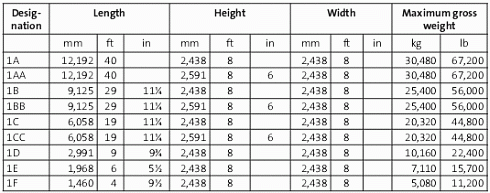 |
At the moment, the following lengths are stated and defined in the metric and/or English customary systems. They relate not only to freight receptacles such as containers but also to swap-bodies:
 |
Current widths are:
 |
Containers of the following heights are in use:
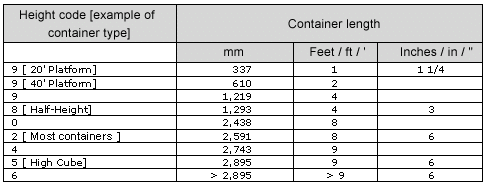 |
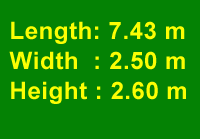 |
Containers 7.43 m long are in principle half-size 49' containers. With a width of 2.50 m and a height of 2.60 m, such containers fulfill the technical requirements and traffic laws of many countries. |
| Containers suitable for international use |
| Proposed size unacceptable in the majority of cases |
 |
The above-mentioned container is virtually identical to the CEN standard C-type swap-body, which is 7.45 m long. However, attempts to introduce such a container with widths of over 2.55 m and heights of over 2.90 m may well meet with resistance.
 |
| Container used mainly in the USA |
The appropriate specialist committees have devoted time to discussing the introduction of 49'/14.9 m long containers with a width of 8' 6"/2.60 m. However, such a container is unacceptable to most of the countries in Africa, Asia, Australasia and Europe. The same applies to a half-length container 24'4½"/7.43 m long, because of the 2.60 m width.
 |
 |
| Maximum mass for a 20' container according to the old standard |
The significant feature of this container is that the term used is the more correct "mass", the unit of mass being correctly stated as the kilogram.
 |
Maximum mass for a 20' container according to DIN ISO 688 |
The term used in this example is weight, as is more usual, but the unit used is that of mass. The correct unit would be the newton. The correct unit would be the newton, with the decanewton or kilonewton [daN, kN] also being possible.
 |
Maximum mass for a 40' container according to the old standard or optionally for a more recent 20' |
The external dimensions of the containers are specified in ISO 668, with the maximum allowable dimensional tolerances being ± 10 mm. The internal dimensions are stated as minimum values. The current internal container dimensions are dependent on the structural material used and the container type selected.
 |
Many of the following statements fall equally within the scope of the operational markings covered in Section 3.5, where additional information may be found.
If real data relating to containers to be ordered and subsequently packed are required for the purpose of forward planning, it is best to refer to the brochures published by shipping companies or other container owners. When packing a container, it is important to cast an eye over the plates affixed to it.
Pallet-compatible containers are 2.50 m wide, for example, and usually carry an appropriate warning:
 |
| Warning affixed to a 2.5 m wide container |
This warning also counts as an operational marking. More detailed information is also to be found in this section.
 |
 |
| External, internal and door dimensions, metric system | |
 |
| Internal and door dimensions, in both feet and inches and millimeters Millimeters |
 |
Dimensions, stated solely in inches and meters |
The following two tables give the lengths and gross weights for 20', 30' and 40' ISO containers and 10' to 40' inland containers.
 |
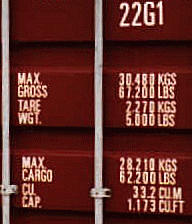 |
20' container with maximum total weight of 30,480 kilograms |
The ISO standard maximum gross weights for inland containers are specified as follows:
 |
The minimum dimensions for the loading areas and volumes of ISO containers are specified as follows:
 |
Data relating to loading areas are very seldom found. Volumes, on the other hand, are almost always stated:
As a rough guide, values are approx. 30 m³ for 20' containers and approx. 67 m³ for 40' containers.
For tank containers, preferred practice is to state their volume in liters rather than in cubic meters:
| Volume in liters on a French tank container |
As already described in Section 3.1.2 CSC & structural and testing regulations, the International Convention for Safe Containers specifies that the maximum gross weight must be marked on the CSC plate. Other regulations require the maximum gross weight and the tare weight to be indicated. This constitutes the minimum information with which the user of the container must be provided by law.
 |
Minimum information on a half-height open-top |
The maximum payload can be calculated as the difference between the maximum gross weight and the tare weight, but this information is already indicated on most containers.
Of interest in this context are the different terms selected by the various container owners. It would be altogether desirable if these terms were to be standardized.
 |
Maximum gross weight - tare weight = permissible payload |
| Tare weight + permissible payload = maximum gross weight |  |
On platform containers, the data are located on the end walls or frame parts.
 |
Markings on platform containers, including weights and other data |
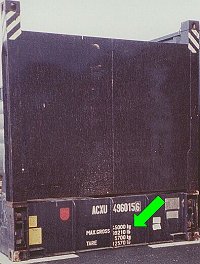 |
 |
Max Gross 45,000 kg or 99,210 lb Tare 5,700 kg or 12,570 lb |
| Markings on a collapsible flatrack with a 45,000 kg maximum weight |
||
Volumes are almost always to be found together with the weight information. On box containers, all the above-mentioned values are usually marked large and clear on the right door leaf.
 |
 |
Weights and volumes on 20' reefers and 40' general purpose containers |
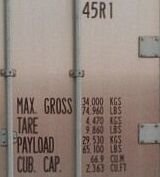 |
 |
Weights and volumes on high-cube reefers and general purpose containers |
Nothing should be stuck over these important data on a container:
 |
The text of the sticker refers limited quantities of hazardous materials and has nothing to do with the maximum gross weight. Loading area and loading capacity (volume) depend principally on wall thickness and structural height. |
| Unfavorably positioned sticker |
| In practice, the ISO standard minimum values for weights and volumes are generally exceeded. Depending on the intended goods transport operation, it may therefore be worth making a comparison and choosing the most favorable container. A comparison of the gross stowage factor with the stowage factor of the respective transport receptacles is always appropriate. Containers often carry information about these aspects (picture to the right). |
 |
| Details of the materials used in a container |
Sometimes, data about dimensions, weights, volumes etc. are also given on the CSC plates themselves or on separate plates:
 |
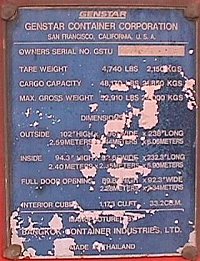 |
| CSC plate giving virtually full information |
Separate plate giving virtually full information |
 |
Separate plate giving weights and dimensions |
An English foot is divided into 12 inches and corresponds to 30.48 cm. An English inch corresponds to 25.4 mm. While inches are conventionally each subdivided into 12 "lines", it is usual to state fractions of an inch, such as ½", ¼", 1/8"or 1/16". An English pound (lb) corresponds to 453.6 g. A cubic foot (cu.ft.) corresponds to 28.35 liters.
Metric units may be roughly converted by rule of thumb into English customary units and vice versa, as follows:
- Meter x 10 ÷ 3 = foot
- Foot ÷ 10 x 3 = meter
- Kilogram x 2 + 10 % = pound
- Pound ÷ 2 - 10 % = kilogram
- Cubic meter x 35 = cubic foot
- Cubic foot ÷ 35 = cubic meter